ASUSTeK Computer RTN12 ASUS WIRELESS SUPERSPEEDN ROUTER User Manual USERS MANUAL 2
ASUSTeK Computer Inc ASUS WIRELESS SUPERSPEEDN ROUTER USERS MANUAL 2
Contents
- 1. USERS MANUAL 1
- 2. USERS MANUAL 2
- 3. USERS MANUAL 3
USERS MANUAL 2

19
Chapter 3: Conguring the clients RT-N12
3
Conguring the
network clients
Accessing the wireless router
Setting an IP address for wired or wireless clients
To access the ASUS Wireless Router, you must have the correct TCP/IP settings
on your wired or wireless clients. Ensure that the clients’ IP addresses are within
the same subnet as the ASUS Wireless Router.
By default, the ASUS Wireless Router integrates the DHCP server function, which
automatically assigns IP addresses to the clients in your network.
But in some instances, you may want to manually assign static IP addresses on
some of the clients or computers in your network rather than automatically getting
IP addresses from your wireless router.
Follow the instructions below that correspond to the operating system installed on
your client or computer.
Note: In the Router mode, if you want to manually assign an IP address to your client, we
recommend that you use the following settings:
• IP address: 192.168.1.xxx (xxx can be any number between 2 and 254. Ensure that the IP
address is not used by another device)
• Subnet Mask: 255.255.255.0 (same as the ASUS Wireless Router)
• Gateway: 192.168.1.1 (IP address of the ASUS Wireless Router)
• DNS: 192.168.1.1 (ASUS Wireless Router) or assign a known DNS server in your network
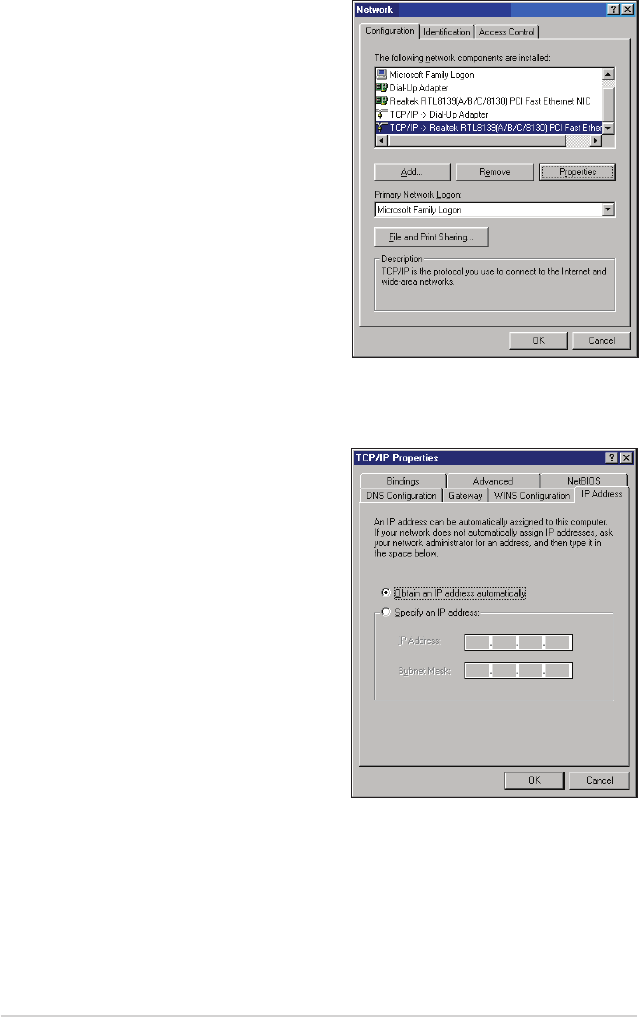
20 RT-N12 Chapter 3: Conguring the clients
Windows® 9x/ME
1. Click Start > Control Panel >
Network to display the Network
setup window.
2. Select TCP/IP then click
Properties.
3. If you want your computer to
automatically obtain an IP address,
click Obtain an IP address
automatically then click OK.
Otherwise, click Specify an
IP address, then key in the IP
address and Subnet Mask.
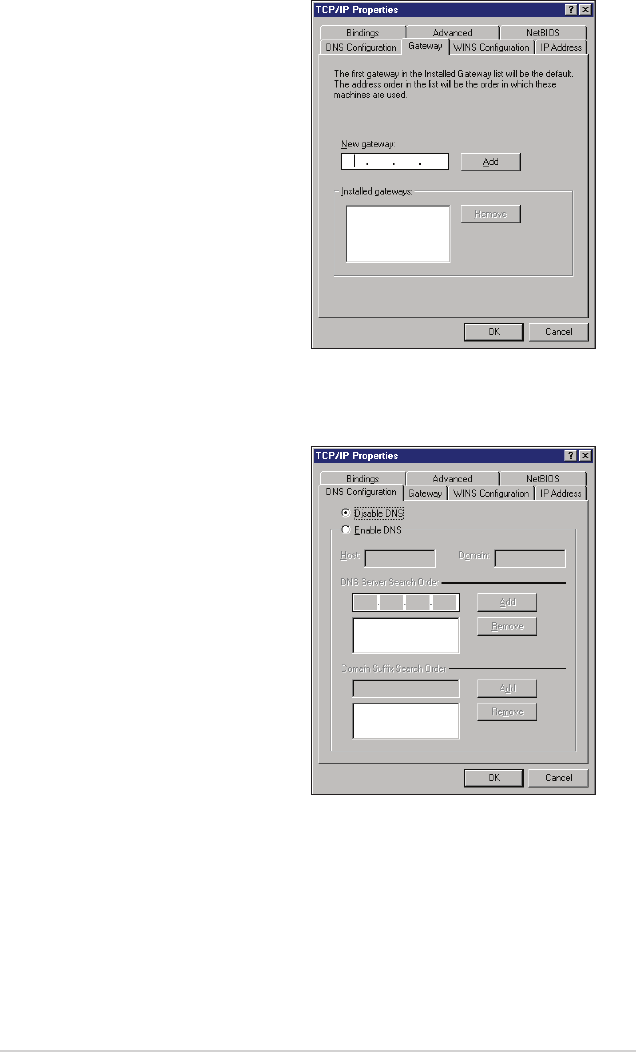
21
Chapter 3: Conguring the clients RT-N12
4. Select the Gateway tab, and key in
New gateway then click Add.
5. Select the DNS conguration tab
and click Enable DNS. Key in Host,
Domain, and DNS Server Search
Order, then click Add.
6. Click OK.
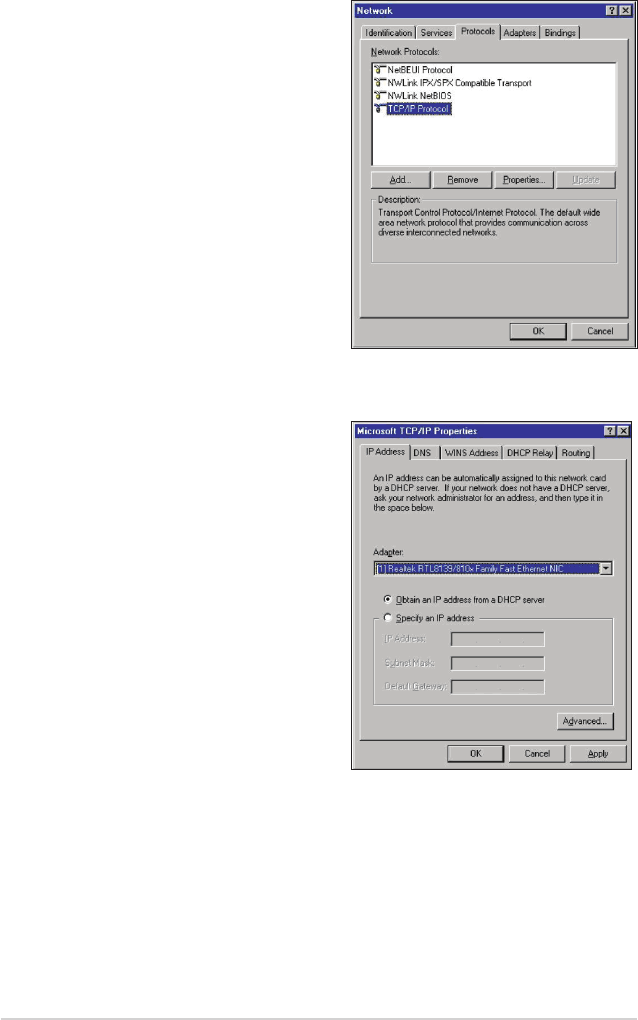
22 RT-N12 Chapter 3: Conguring the clients
Windows® NT4.0
1. Go to Control Panel > Network to
display the Network setup window
then select the Protocols tab.
2. Select TCP/IP Protocol from the
Network Protocols list then click
Properties.
3. From the IP Address tab of the
Microsoft TCP/IP Properties
window, you can:
• Select the type of network
adapter installed in your
system.
• Set the router to assign IP
address automatically.
• Manually set up the IP address,
subnet mask, and default
gateway.
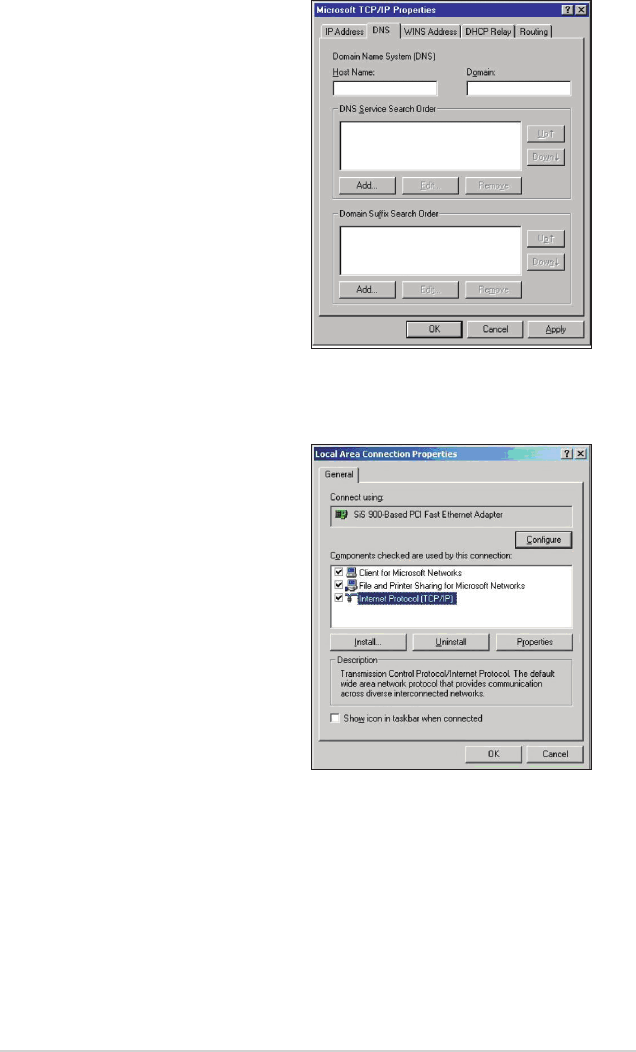
23
Chapter 3: Conguring the clients RT-N12
4. Select the DNS tab then click Add
under the DNS Service Search
Order and key in DNS.
Windows® 2000
1. Click Start > Control Panel >
Network and Dial-up Connection.
Right-click Local Area Connection
then click Properties.

24 RT-N12 Chapter 3: Conguring the clients
2. Select Internet Protocol (TCP/IP),
then click Properties.
3. Select Obtain an IP address
automatically if you want
the IP settings to be assigned
automatically. Otherwise, select
Use the following IP address: and
key in IP address, Subnet mask,
and Default gateway.
4. Select Obtain DNS server
address automatically if you
want the DNS server settings to be
assigned automatically. Otherwise,
select Use the following DNS
server addresses: and key in the
Preferred and Alternate DNS
server.
5. Click OK when done.
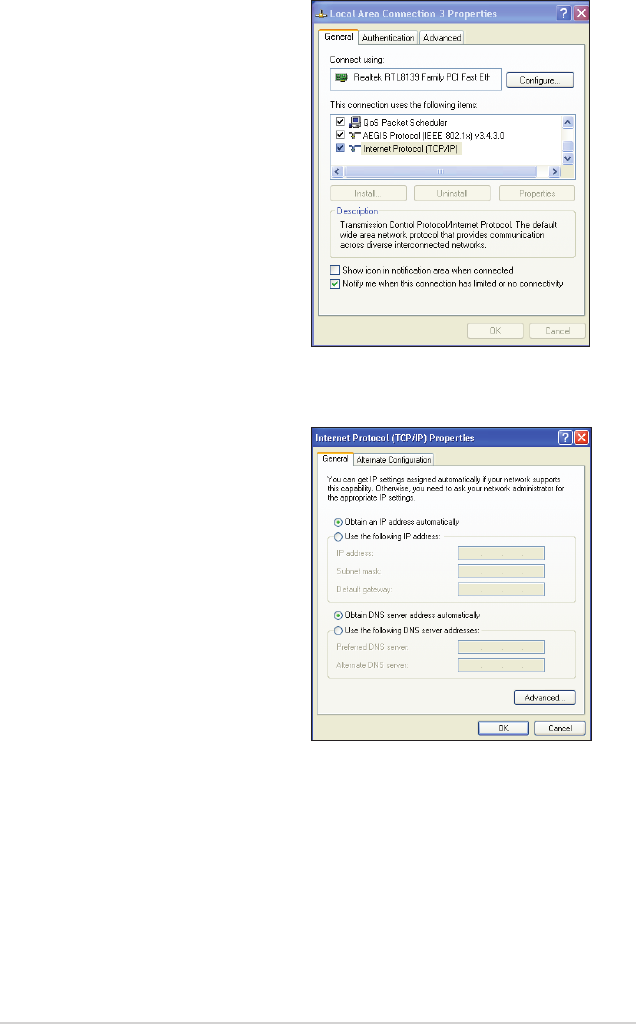
25
Chapter 3: Conguring the clients RT-N12
2. Select Internet Protocol (TCP/IP),
then click Properties.
3. Select Obtain an IP address
automatically if you want
the IP settings to be assigned
automatically. Otherwise, select
Use the following IP address: and
key in IP address, Subnet mask,
and Default gateway.
4. Select Obtain DNS server
address automatically if you
want the DNS server settings to be
assigned automatically. Otherwise,
select Use the following DNS
server addresses: and key in the
Preferred and Alternate DNS
server.
5. Click OK when done.
Windows® XP
1. Click Start > Control Panel >
Network Connection. Right-click
Local Area Connection then select
Properties.
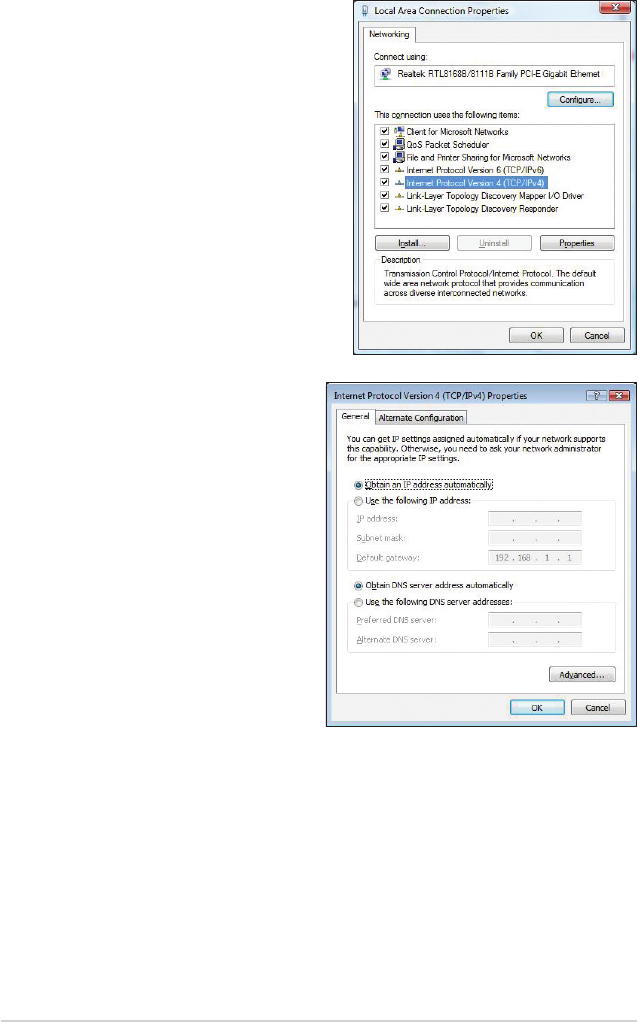
26 RT-N12 Chapter 3: Conguring the clients
Windows® Vista
1. Go to Start > Control Panel >
Network and Internet > Network
and Sharing Center. Click View
status > Properties > Continue.
2. Select Internet Protocol
Version 4 (TCP/IPv4), then click
Properties.
3. Select Obtain an IP address
automatically if you want
the IP settings to be assigned
automatically. Otherwise, select
Use the following IP address:
and key in IP address and
Subnet mask.
4. Select Obtain DNS server
address automatically if you
want the DNS server settings
to be assigned automatically.
Otherwise, select Use the
following DNS server
addresses: and key in the
Preferred and Alternate DNS
server.
5. Click OK when done.
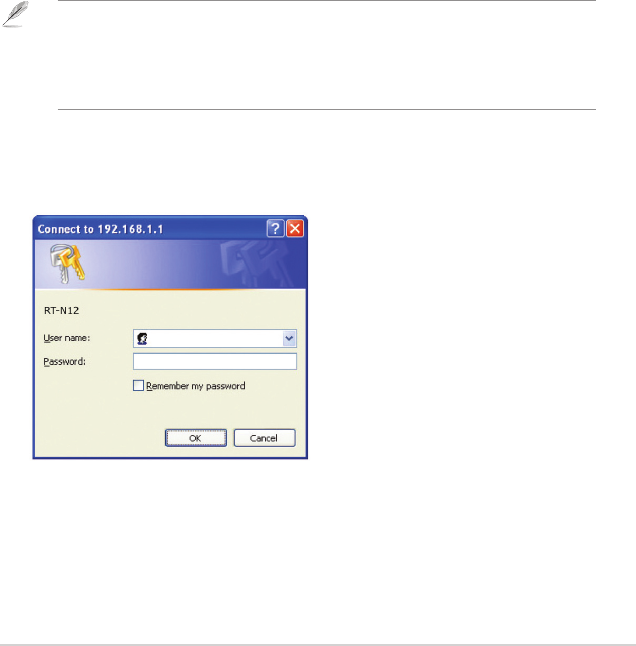
27
Chapter 4: Conguring via the web GUI RT-N12
4
Conguring via
the web GUI
Conguring via the web GUI
The router’s web graphics user interface (web GUI) allows you to congure these
features: Network Map and EZQoS Bandwidth Management.
To access the web GUI:
1. Launch a web browser, then key in the router’s IP address. The login page of
the router’s web GUI appears.
2. On the login page, key in the default user name (admin) and password
(admin).
Note:
• In the Router mode, the router’s IP address is 192.168.1.1.
• In the Repeater and AP modes, use Device Discovery included in the support CD to nd the
router’s IP address.

28 RT-N12 Chapter 4: Conguring via the web GUI
3. From the main page, click the navigation menu or links to congure the various
features of the ASUS Wireless Router.
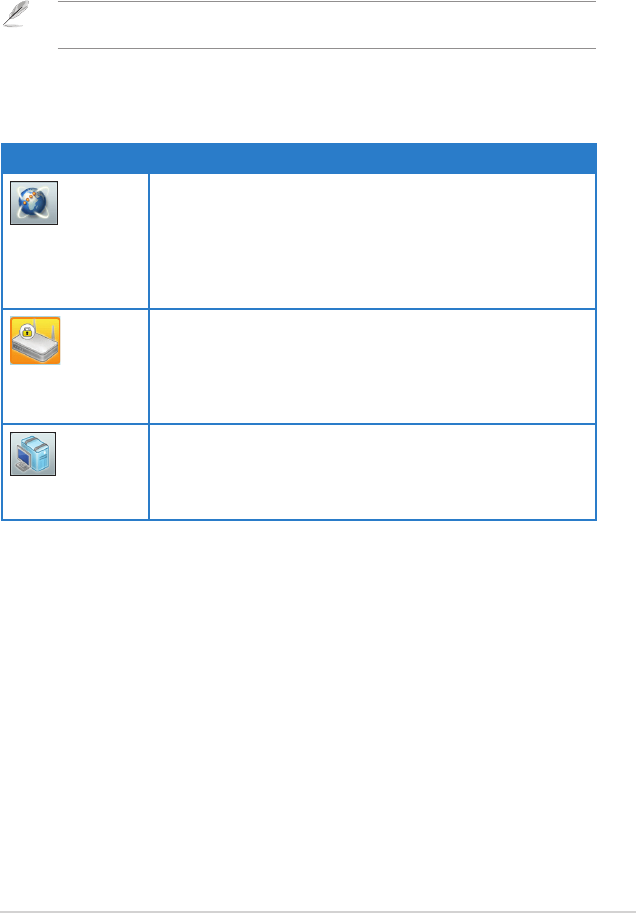
29
Chapter 4: Conguring via the web GUI RT-N12
Using the Network Map
Network Map allows you to view the status and congure the connection settings
of the Internet, system, and clients in your network. It enables you to quickly set up
your Wide Area Network (WAN) using the Quick Internet Setup (QIS) feature, or to
quickly set up your Local Area Network (LAN) using the WPS Wizard.
Note: For more details on the WPS Wizard, refer to the section WPS Wizard in Chapter 5 of this
user manual.
To view the status or congure the settings, click any of these icons displayed on
the main page:
Icon Description
Internet status
Click this icon to display information on the Internet
connection status, WAN IP address, DNS, connection type,
and gateway address. From the Internet status screen, use
the Quick Internet Setup (QIS) feature to quickly set up your
network.
System status
Click this icon to display information on the SSID,
authentication and encryption methods, LAN IP, MAC
address, or turn the wireless radio on/off. Enable the WPS
mode from the System status screen.
Client status
Click this icon to display information about the clients or
computers in the network, and allows you to block/unblock
a client.
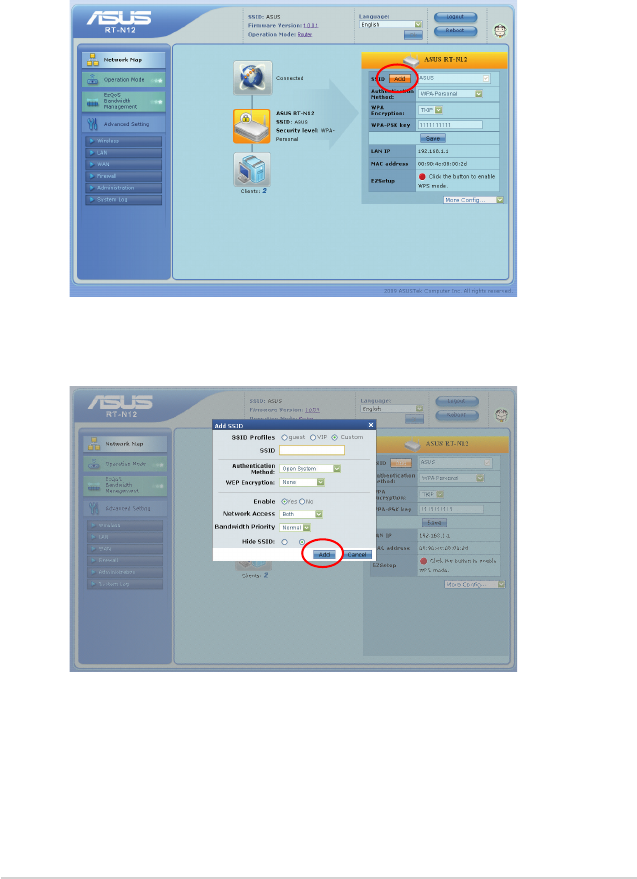
30 RT-N12 Chapter 4: Conguring via the web GUI
Creating multiple SSID proles
The wireless router allows you to create multiple SSID proles that meet various
working scenarios.
To create an SSID prole:
1. Under System status, click Add.
2. Congure the prole settings, then click Add.
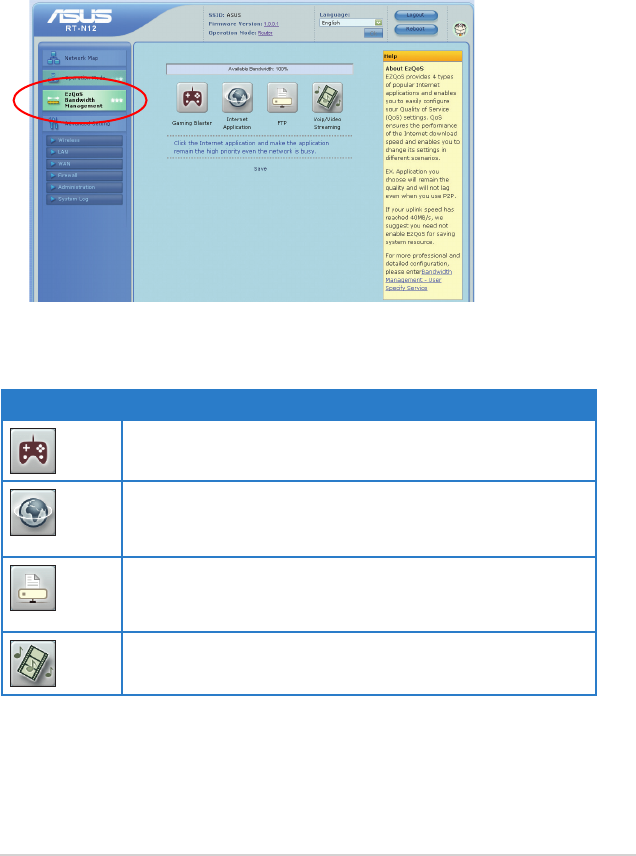
31
Chapter 4: Conguring via the web GUI RT-N12
Managing bandwidth with EzQoS
EzQoS Bandwidth Management enables you to set the bandwidth priority and
manage the network trafc.
To set up the bandwidth priority:
1. Click EzQoS Bandwidth Management from the navigation menu at the left
side of your screen.
2. Click each of these four applications to set the bandwidth priority:
Icon Description
Gaming Blaster
The router handles gaming trafc at rst priority.
Internet Application
The router handles the e-mail, web browsing and other Internet
applications trafc at rst priority.
FTP
The router handles at rst priority the trafc of downloading/
uploading data to/from the FTP server.
Voip/Video Streaming
The router handles the audio/video trafc at rst priority.
3. Click Save to save the conguration settings.
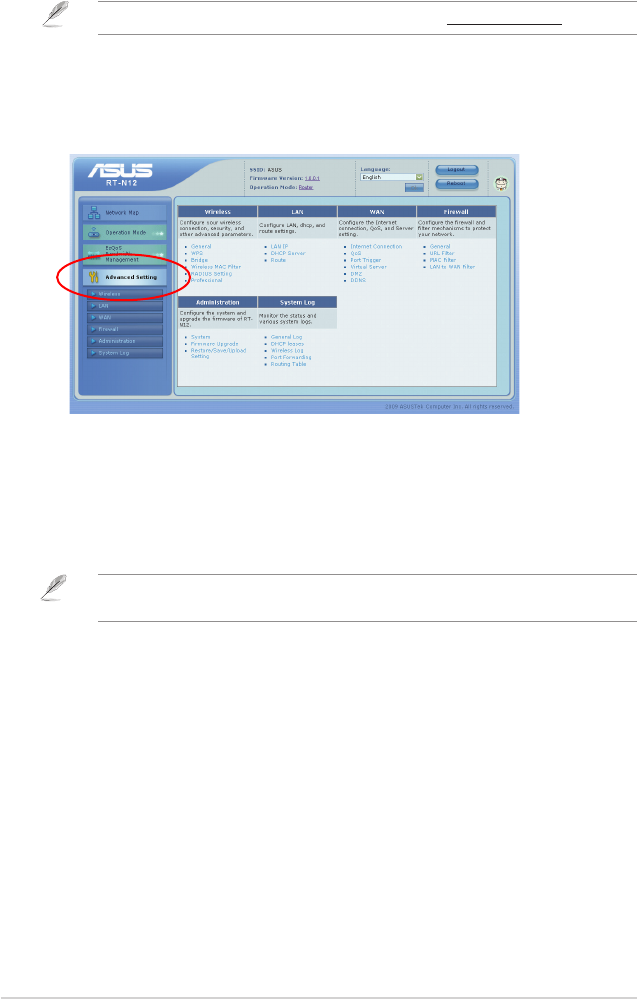
32 RT-N12 Chapter 4: Conguring via the web GUI
Upgrading the rmware
Note: Download the latest rmware from the ASUS website at http://www.asus.com.
To upgrade the rmware:
1. Click Advanced Setting from the navigation menu at the left side of your
screen.
2. Under the Administration menu, click Firmware Upgrade.
3. In the New Firmware File eld, click Browse to locate the new rmware on your
computer.
4. Click Upload. The uploading process takes about three minutes.
Note: If the upgrade process fails, use the Firmware Restoration utility to restore the system. For
details on this utility, refer to the section Firmware Restoration in Chapter 5 of this user manual.
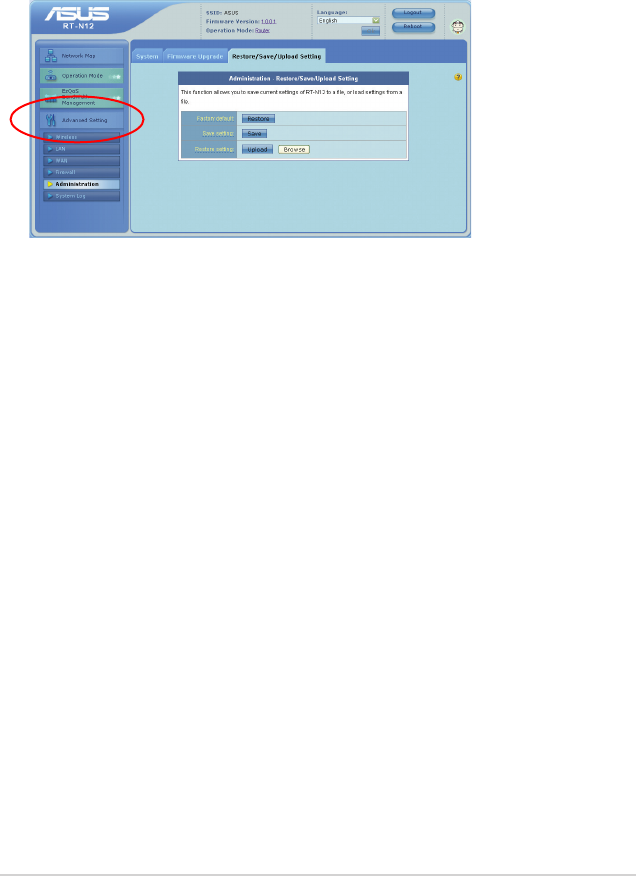
33
Chapter 4: Conguring via the web GUI RT-N12
Restoring/Saving/Uploading settings
To restore/save/upload the settings:
1. Click Advanced Setting from the navigation menu at the left side of your
screen.
2. Under the Administration menu, click Restore/Save/Upload Setting.
3. Select the tasks that you want to do:
• To restore to the default factory settings, click Restore, and click OK in the
conrmation message.
• To save the current system settings, click Save, and click Save in the le
download window to save the system le in your preferred path.
• To restore previous system settings, click Browse to locate the system le that
you want to restore, then click Upload.